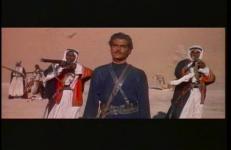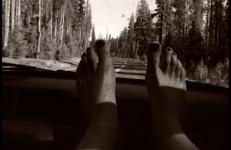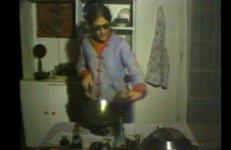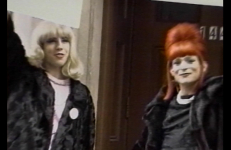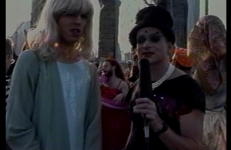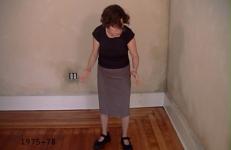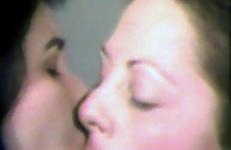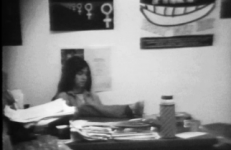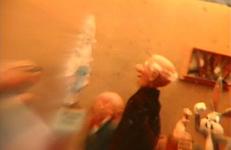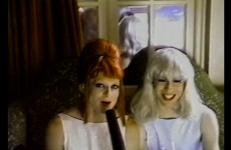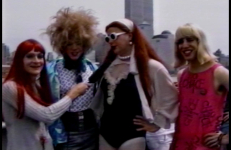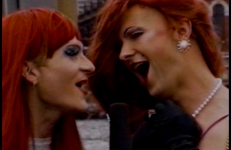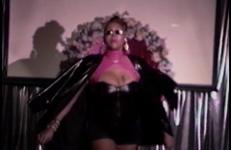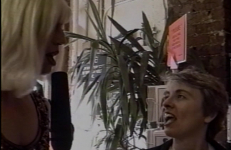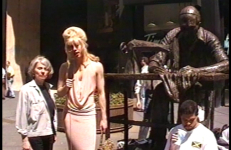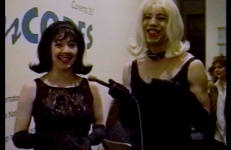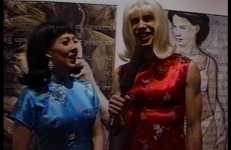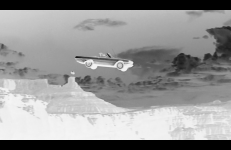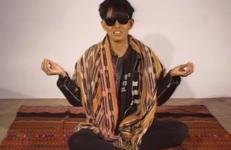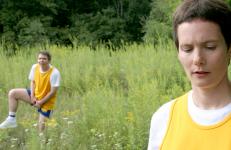Dramatically Repeating Lawrence of Arabia is a re-edit of David Lean’s 217-minute orientalist “classic” Lawrence of Arabia into a 15-minute hallucination of repeating masculinized poses, costumes and dramatic gestures. An algorithmic structure condenses and frame-by-frame remixes the original film into a cycling of divergence, convergence and momentary mirrorings.
Gender
Sassy, iconoclastic, and never-married, Los Angeles filmmaker Susan Mogul rides shotgun with ex-lovers, almost lovers, and her Dad, in a road movie turned inside out. Conversations with each driving man - pornographer, tuba player, TV critic, long haul truck driver, and more - are catalysts to reflect upon the past and comment about the present.
Rosler uses the format of a cooking demonstration (as in Semiotics of the Kitchen) to address cultural transaction--the meeting of Eastern and Western cultures. Reading directly from a West Bend Electric Wok instruction booklet, Rosler wryly comments upon the Oriental mystique conjured by the West Bend manufacturers, a mystique evoked and then "improved" upon through Western technology--i.e. non-stick surfaces and electric power.
A short documentary about life in the Everglades National Park with its few male residents. Living in the midst of a national park, they learn to exist with the wild. As a female moving image artist, Dana Levy takes on the role of an anthropologist, observing the men and how they interact with their surroundings. Apart from Levy, the only women that appear in Eden Without Eve are in erotic photographs taken by a resident named Lucky, who believes that women like having themselves put in romantic, exotic, and dangerous settings to be photographed.
Equal Rights for Unborn Drag Queens is a satirical short video in which Brenda and Glennda critique anti-abortion politics, homophobia, and religious fanaticism in the media. Interspersed between clips of right-wing news broadcasts is footage of Brenda having her nipple pierced, in an homage to Sandy Daley's Robert Having His Nipple Pierced (1971).
An episode of The Brenda and Glennda Show hosted by Brenda Sexual and Glennda Orgasm.
In Fagtasia Solstice, Brenda and Glennda attend a Radical Faerie event in New York City to commemorate the Summer Solstice. Through interviews with Faeries and footage of their walk across the Brooklyn Bridge, the group proposes to reclaim the city as a safe space for queer people, and discuss reorienting queer consciousness toward spirituality.
An episode of The Brenda and Glennda Show, hosted by Brenda Sexual and Glennda Orgasm. Featuring the Radical Faeries. Thanks to Julie Clark and Dana Nasrallah.
The Fancy is a speculative, experimental work that explores the life of Francesca Woodman (1958-1981), evoked by the published catalogues of and about her photographs. Structural in form, the video radically reorganizes information from the catalogues in order to pose questions about biographical form, history and fantasy, female subjectivity, and issues of authorship and intellectual property.
As two heavily made-up women take turns directing each other and submitting to each other's kisses and caresses, it becomes increasingly obvious that the camera is their main point of focus. Read against feminist film theory of the "male gaze", the action becomes a highly charged statement of the sexual politics of viewing and role-playing; and, as such, is a crucial text in the development of early feminist video.
In 1975, the Feminist Studio Workshop (I was a member) at the Woman’s Building in LA, the Women’s Interart Center in New York City, and another feminist organization in Washington DC, attempted to set up a video exchange among feminist art organizations. This was the first videoletter on our end. I don’t know if another one was ever made.
The videoletter is a tour of the Woman’s Building. Pam McDonald, with microphone in hand, another workshop member, and myself, served as guides through the building. It was shot with a black and white video portopack.
I just got this tattoo — you can see it's still healing, the edges are raised like some sort of fancy business card — to mark the completion of this, Series One of my on-going project, Final Thoughts. So, on one wrist, facing fistward, a skull and, on the other, still tender and healing, a ghost. Let them be the mascots for the series, little cartoony avatars.
In From Fagtasia to Frisco, Brenda and Glennda report from Fagtasia, an event honoring the Summer Solstice in New York organized by the Radical Faeries. Through interviews with Faeries and footage of their walk across the Brooklyn Bridge, the group proposes to reclaim the city as a safe space for queer people, and discuss reorienting queer consciousness toward spirituality.
This two-part video Gender Cruise on the Circle Line involves Brenda and Glennda leading a group of drag queens, drag kings, and other gender nonconforming people on a three-hour ride on the Circle Line boat around Manhattan.
The two-part video Gender Cruise on the Circle Line involves Brenda and Glennda leading a group of drag queens, drag kings, and other gender nonconforming people on a three-hour ride on the Circle Line boat around Manhattan.
In Glennda and Bruce Do Times Square, Glennda is taken on a night tour of Times Square by author Bruce Benderson. They observe the dynamic between forms of culture that would typically be identified as “underclass” in “suburbanite” culture within the economic and spatial landscape of New York City. Glennda and Bruce visit the apartment of performer Consuela Cosmetic, who was prolific within New York’s ball scene. She maps out the ways in which she believes gender can be expressed, and discusses the implications of ‘passing’.
In this video, Glennda Orgasm and social critic Camille Paglia walk the streets of downtown Manhattan and discuss the status of mainstream feminism in the early 1990s. They visit the Stonewall Inn, Washington Square Park, and a gay bookstore, and confront a group of anti-pornography protesters.
An episode of Glennda and Friends, hosted by Glennda Orgasm and Camille Paglia. Featuring The Centaurians, Brian Roach, and Rennard Snowden.
In this video, Glennda is joined by social critic and feminist scholar Camille Paglia in New York's fashion district. The pair visit designers studios to discuss their respective styles and creative processes. Additionally, Glennda and Camille explore fashion's relationship to gender and feminism, ultimately recreating an iconic scene from Breakfast at Tiffany's.
An episode of Glennda and Friends, hosted by Glennda Orgasm and Camille Paglia.
In this video, Glennda and sex activist Chris Teen attend the opening of Dress Codes at Boston's Institute of Contemporary Art. They interview museum staff, artists, and other attendees to explore how an exhibition centered upon gender nonconformity will be received by both queer communities and the general public. Glennda and Chris Teen discuss the importance of visibility for marginalized communities, and tap into gender discourses as they existed in the early 1990s.
In this video, Glennda Orgasm and Chris Teen travel to Washington, DC to attend a feminist art exhibition titled Walk the Goddess Walk at the District of Columbia Arts Center. The pair talk to the owner of the gallery, artists included in the show, and attendees, including Francy Caprino, Teena Cromwell, Andrew Melon, Camille Paglia, and Joseph Virgilio.
An episode of Glennda and Friends, hosted by Glennda Orgasm and Chris Teen.
In this video, Glennda and Judy LaBruce (Bruce LaBruce) visit the auction house Christie's East on New York's Upper East Side to view Judy Garland memorabilia that is being auctioned off. They attempt to rescue Garland's Oscar from those trying to profit from the auction.
An episode of Glennda and Friends, hosted by Glennda Orgasm and Judy LaBruce.
In the video Glennda does DC, Glennda interviews people in Washington D.C. about the topic of gay rights. As the National Gay and Lesbian Task Force Conference is going on simaltaneously, she asks people if they were aware of this, and if they believe that there should be a gay rights bill.
Goodbye Thelma synthesizes footage from the 1991 film Thelma & Louise with footage of the author’s own making to create a mysterious, and at times disturbing, exploration of traveling alone. In contrast to the dramatic events of Thelma & Louise, this story is one of suspended fear, which inverts stunning vistas into unsettling and uncertain landscapes.
With an all-female cast, featuring Suzie Bright as John Lennon, Cecilia Dougherty's Grapefruit plays with the romanticized history of the iconic Fab Four, gently mocking John and Yoko’s banal squabbles and obsessive rituals of self-display. Based obliquely on Yoko Ono’s book, the piece works on many levels to reposition this mythic tale of the Beatles by casting '80s women in mod drag—effectively mapping the lesbian sub-culture onto heterosexual mass culture.
Identically dressed, and with sibling-like resemblance, performance artists Trevor Martin and Kym Olsen shift between spoken word and athletic dance choreography in a collection of 29 scenes. Set in various locations--including a gymnasium, an abandoned hospital, and a trailer park circus--Martin and Olsen slip between a ventriloquist and his dummy, a seducer and his surrogate, a doctor and his patient, and synchronized dance partners. The film examines a complex social psychology--questioning the colonization of the human body for various political, medical and religious agendas.
Identically dressed, and with sibling-like resemblance, performance artists Trevor Martin and Kym Olsen shift between spoken word and athletic dance choreography in a collection of 29 scenes. Set in various locations--including a gymnasium, an abandoned hospital, and a trailer park circus--Martin and Olsen slip between a ventriloquist and his dummy, a seducer and his surrogate, a doctor and his patient, and synchronized dance partners. The film examines a complex social psychology--questioning the colonization of the human body for various political, medical and religious agendas.
Identically dressed, and with sibling-like resemblance, performance artists Trevor Martin and Kym Olsen shift between spoken word and athletic dance choreography in a collection of 29 scenes. Set in various locations--including a gymnasium, an abandoned hospital, and a trailer park circus--Martin and Olsen slip between a ventriloquist and his dummy, a seducer and his surrogate, a doctor and his patient, and synchronized dance partners. The film examines a complex social psychology--questioning the colonization of the human body for various political, medical and religious agendas.




